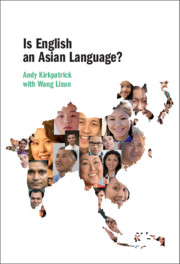Book contents
- Is English an Asian Language?
- Is English an Asian Language?
- Copyright page
- Dedication
- Contents
- Figures and Tables
- Introduction
- 1 How English Came to Asia
- 2 The Asian Corpus of English
- 3 Asian Varieties of English vs English as a Lingua Franca (ELF) in Asia
- 4 What Do Asian Multilinguals Talk about When Using English as a Lingua Franca?
- 5 The Transfer of Features and Communicative Strategies
- 6 Borrowing Words and Writing Asian Englishes
- 7 Non-standard Forms in Asian Englishes and ELF
- 8 English in Law, Religion and Popular Culture
- 9 English as a Language of Education in Asia
- 10 Implications for English Language Teaching in Asia
- 11 Conclusion
- References
- Index
2 - The Asian Corpus of English
Published online by Cambridge University Press: 15 October 2020
- Is English an Asian Language?
- Is English an Asian Language?
- Copyright page
- Dedication
- Contents
- Figures and Tables
- Introduction
- 1 How English Came to Asia
- 2 The Asian Corpus of English
- 3 Asian Varieties of English vs English as a Lingua Franca (ELF) in Asia
- 4 What Do Asian Multilinguals Talk about When Using English as a Lingua Franca?
- 5 The Transfer of Features and Communicative Strategies
- 6 Borrowing Words and Writing Asian Englishes
- 7 Non-standard Forms in Asian Englishes and ELF
- 8 English in Law, Religion and Popular Culture
- 9 English as a Language of Education in Asia
- 10 Implications for English Language Teaching in Asia
- 11 Conclusion
- References
- Index
Summary
Chapter 2 introduces the ACE, a corpus of naturally occurring English as spoken as a lingua franca by Asian multilinguals, in a wide range of speech events: interviews; press conferences; service encounters; seminar discussions; working group discussions; workshop discussions; meetings; panels; question-and-answer sessions; and conversations, categorized under five major settings: education (25%), leisure (10%), professional business (20%), professional organisation (35%), and professional research/science (10%). ACE was collected to act as a complementary corpus to the VOICE, a corpus of naturally occurring English used as a lingua franca in primarily European settings. ACE data have been tagged following the transcription conventions originally developed by the VOICE project team. Users can browse the corpus data according to the five settings or according to the various data collection sites. A Web concordancer has been developed which allows users to search any word/phrase in ACE, and collocation information of the search word/phrase will be illustrated. Researchers and teachers/learners can explore the ACE data for various research and pedagogical purposes.
- Type
- Chapter
- Information
- Is English an Asian Language? , pp. 30 - 52Publisher: Cambridge University PressPrint publication year: 2020
- 1
- Cited by

